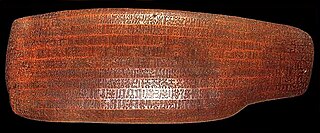
Rongorongo is a system of glyphs discovered in the 19th century on Rapa Nui that appears to be writing or proto-writing. Numerous attempts at decipherment have been made, with none being successful. Although some calendrical and what might prove to be genealogical information has been identified, none of these glyphs can actually be read. If rongorongo does prove to be writing and proves to be an independent invention, it would be one of very few independent inventions of writing in human history.
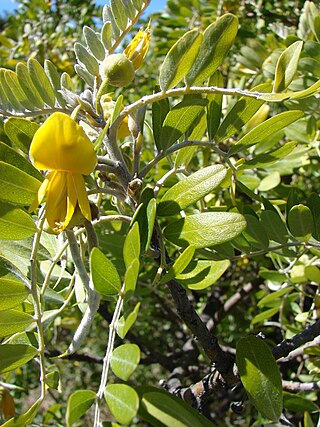
Sophora is a genus of about 45 species of small trees and shrubs in the pea family Fabaceae. The species have a pantropical distribution. The generic name is derived from sophera, an Arabic name for a pea-flowered tree.

Abeliophyllum, the miseonnamu, Korean abeliophyllum, white forsythia, or Korean abelialeaf, is a monotypic genus of flowering plants in the olive family, Oleaceae. It consists of one species, Abeliophyllum distichumNakai, endemic to Korea, where it is endangered in the wild, occurring at only seven sites. It is related to Forsythia, but differs in having white, not yellow, flowers.
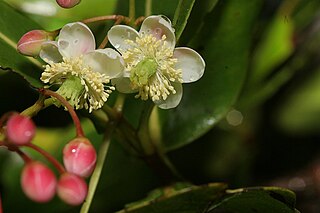
Medusagyne oppositifolia, the jellyfish tree, is a species of tree endemic to the island of Mahé, of the Seychelles. It is the only member of the genus Medusagyne of the tropical tree and shrub family Ochnaceae. The plant, thought to be extinct until a few individuals were found in the 1970s, gets its common name from the distinctive jellyfish-like shape of its dehisced fruit.

Jubaea is a genus of palms with one species, Jubaea chilensis or Jubaea spectabilis, commonly known in English as the Chilean wine palm or Chile cocopalm, and palma chilena in Spanish. It is native to southwestern South America and is endemic to a small area of central Chile between 32°S and 35°S in southern Coquimbo, Valparaíso, Santiago, O'Higgins, and northern Maule regions.

The Gothenburg Botanical Garden is located in Gothenburg, Sweden, and is one of the larger botanical gardens in Europe.
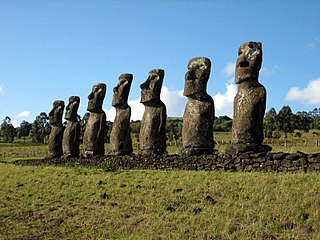
Rapa Nui National Park is a national park and UNESCO World Heritage Site located on Easter Island, Chile. Rapa Nui is the Polynesian name of Easter Island; its Spanish name is Isla de Pascua. The island is located in the southeastern Pacific Ocean, at the southeastern extremity of the Polynesian Triangle. The island was taken over by Chile in 1888. Its fame and World Heritage status arise from the 887 extant stone statues known by the name "moai", whose creation is attributed to the early Rapa Nui people who inhabited the island starting between 300 and 1200 AD. Much of the island has been declared as Rapa Nui National Park which, on 22 March 1996, UNESCO designated a World Heritage Site under cultural criteria (i), (iii), & (v). Rapa Nui National Park is now under the administrative control of the Ma´u Henua Polynesian Indigenous Community, which is the first autonomous institute on the island. The indigenous Rapa Nui people have regained authority over their ancestral lands and are in charge of the management, preservation and protection of their patrimony. On the first of December 2017, the ex-President Michelle Bachelet returned ancestral lands in the form of the Rapa Nui National Park to the indigenous people. For the first time in history, the revenue generated by the National Park is invested in the island and used to conserve the natural heritage.

Brahea edulis, the Guadalupe palm or palma de Guadalupe, is a palm endemic to Guadalupe Island, Mexico, although a few stands have been planted elsewhere. It is a fan palm which grows 4.50 to 13 metres tall. It grows on the island between 400 and 1,000 metres above mean sea level (ASL), with this altitudinal zonation producing one of the few fog oases present in North America.
Sauropus assimilis is an extremely rare species of plant in the family Phyllanthaceae. It is a tree growing in wet evergreen forests in lowlands. Endemic to southwestern Sri Lanka, and only known from the Sinharaja Biosphere Reserve there, evidence of its existence was last catalogued before 1991, and it has not been found since then. It may since have become extinct.

Xylopia africana is a species of plant in the Annonaceae family. It is found in west-central Africa. It is restricted to submontane and lower montane forests. It is threatened due to habitat loss by clearance of forest. It was first described as Melodorum africanum in 1862 by George Bentham.
The Lost Gods of Easter Island is a BBC documentary written and presented by David Attenborough. It explores the history of the civilization of remote Easter Island. It was first transmitted in 2000 and is part of the Attenborough in Paradise and Other Personal Voyages collection of seven documentaries.

Paschalococos disperta, the Rapa Nui palm or Easter Island palm, formerly Jubaea disperta, was the native coccoid palm species of Easter Island. It disappeared from the pollen record circa AD 1650.

The Jardin botanique exotique de Menton, also known as the Jardin botanique exotique du Val Rahmeh, is a botanical garden located off Avenue St Jacques, Menton, Alpes-Maritimes, Provence-Alpes-Côte d'Azur, France. It is open daily except Tuesday; an admission fee is charged.

The Botanische Garten der Martin-Luther-Universität Halle-Wittenberg is an arboretum and botanical garden maintained by the University of Halle-Wittenberg. It is located at Am Kirchtor 3 in the city of Halle, Saxony-Anhalt, Germany, and open daily in the warmer months. An admission fee is charged.

Cornutia obovata is a rare species of tree in the mint family, and formerly considered a member of the verbena family. It is endemic to forested slopes in Puerto Rico, where its common names are capá jigüerilla, nigua, and palo de nigua. When it was added to the endangered species list of the United States in 1988 there were only seven individuals known to remain in the wild. By 1998 there were eight plants known. This is considered one population divided amongst a few locations in the mountain forests of the island.

Abutilon pitcairnense, the yellow fatu or yellow fautu, is a critically endangered perennial plant that is native to Pitcairn Island. It was once considered extinct, until a single plant was discovered on the island in 2003. At that time, cuttings and seed were used to propagate several plants at a nursery on the island and botanical gardens in Ireland and England. The last wild surviving plant died in a landslide in 2005, making the plant extinct in the wild.
Alastair Culham is an English botanist. He is a member of the staff of the School of Biological Sciences at the University of Reading and Curator of the University of Reading Herbarium (RNG). He specialises in plant taxonomy, biosystematics and applications of techniques from molecular biology, phytogeography and phylogenetics. He focuses on broad-based research in biodiversity and taxonomy.
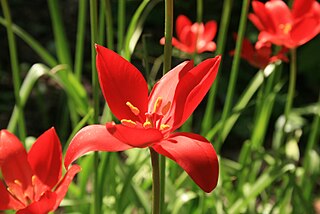
Tulipa sprengeri, or Sprenger's tulip, is a wild tulip from the Pontic coast of Turkey. It is quite rare and possibly extinct in the wild, but widely cultivated as an ornamental.

Dracaena umbraculifera is a tree species only known from botanical gardens since the end of the 18th century, the original sample was labelled as originating from the island nation of Mauritius. It was declared to be extinct by the IUCN in 1997. This was clearly incorrect, as there are living specimens in botanical gardens around the world. Searches on Mauritius failed to find any trees, however, so it was thought that the IUCN probably should have more correctly assessed the species as 'extinct in the wild'. As such a team of researchers at the Missouri Botanical Garden decided to 'reintroduce' the species back to Mauritius in 2011, clones were propagated by cuttings and planted out in Mauritius in 2012.



















